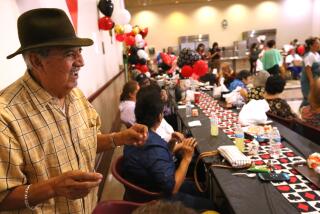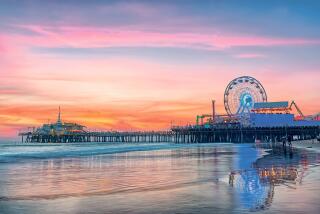Does size matter?
Los Angeles was sold to 20th century America as the city of sunshine, health and happiness -- the favored place of suburbs, swimming pools, tans and movie stars. But if you needed one number to encapsulate the extravagant promise of L.A., you cited the city’s population and marveled at its phenomenal rate of growth. That number was the measure of what we wanted to be and how much this place was desired. It was the one number that defined us.
The number of Angelenos was everywhere in boomtown Los Angeles -- on postcards to send back to “the folks” in Wichita and Buffalo, in brochures from the Chamber of Commerce and, most prominently, in the pages of the Los Angeles Times. Cartoons in newspapers showed the shapely figure of a prodigiously growing senorita, in each decade from the 1880s doubling or tripling in size. Like a prize heifer at the county fair, the city was obsessively measured by its many booster organizations because size mattered to builders; to suppliers of water, electricity and natural gas; and to the industries that located plants here to make tires, automobiles and steel.
It mattered that L.A.’s population outstripped every other major city on the West Coast. It mattered most that Los Angeles in 1930, at 1,231,370 residents, was twice the size of San Francisco, the city’s historic rival. From 1900 to 1930, Los Angeles grew by 1,300%.
The potency of the city’s sales pitch, its happy climate and the liberating newness of everything in Los Angeles propelled the growth of the number through the Depression and into the postwar decades. Between 1930 and 1960, the city’s population doubled in size again, to 2,481,595.
Los Angeles then had a disciplined class of boosters made up of plant managers, bankers, insurance executives and large landowners (including the Chandler family, former owners of The Times). They capitalized on the city’s history of resistance to organized labor, its weak government and its well-oiled machine of suburban development to make Los Angeles the unrivaled alternative to New York. For all its faults, L.A. was supposed to be the metropolis of tomorrow -- big, optimistic and firmly middle class in character.
The number of Angelenos in the city -- now an estimated 3,834,340 -- does not excite that kind of pride and wonder anymore. In recent years, the city’s population has hardly grown at all. From 2000 to 2007, Los Angeles grew an estimated 3.8% (just slightly ahead of San Diego but well behind Pasadena). Old rival San Francisco’s population actually fell 1.5%. Between mid-2006 and mid-2007, the population of Los Angeles went up by only 0.3% -- by 10,832 -- according to census estimates issued July 10.
The big numbers are elsewhere, mostly in Texas, the Carolinas, Florida and Arizona, where double-digit population growth is the norm. The growth factors in these states -- industry relocation, weak unions and governments eager for new development -- mirror the Los Angeles story of 80 years ago. No developer in America will ever go broke selling climate and the open shop, as long as there is another patch of open land on which to build. But unlike the fast-growing Sun Belt cities, Los Angeles has no more fringe to expand into. Crowding its edges are half a dozen large cities with population growth greater than or nearly equal to that of Los Angeles. And there are more than 80 smaller cities in the county that have nowhere to grow themselves.
L.A.’s intoxication with its defining number seems to be over. Current booster literature makes no mention of how big the city is. And in sobering up, we have a lot to account for. The city today has just two business categories that reliably produce middle-class wages -- the entertainment industry and the movement of goods to and from Los Angeles ports. Comparable jobs in other industries, according to the Los Angeles County Economic Development Commission, will decline by another 20,000 in 2008. Some new jobs will be created by government, but that is hardly a sign of economic strength.
As a result, the city is bleeding its middle class -- the often-mocked “folks” who once were the city’s largest demographic. Today’s educated and enterprising 25- to 35-year-olds are not replacing them because Los Angeles does not have enough jobs for them or the kind of homes they seek at a price they can afford.
Growth is what the structure of Los Angeles government was re-created in the early 1920s to foster, and every administration through the 1980s was ultimately measured by its ability to get out of growth’s way. How city government should act now, in a barely growing Los Angeles, remains elusive.
Yet the seduction of the number persists. The New York Times, because the city’s population is static, recently clumped Los Angeles with the old and fading cities of the East. Hardly. The city’s population number says next to nothing about the symbiosis between Los Angeles and the region around it, with a combined population of 13 million and an economy that functions more like that of a state than a metropolitan area. Predictions about the future of suburban versus urban development -- who will win and who will lose -- are confounded by the hybrid nature of the Los Angeles region, which is both very suburban and as dense as many Eastern cities.
Once, a single number summed up the appeal and speed of Los Angeles. But the number always concealed more than it revealed. Counting Angelenos has never given a good account of who they are or what they want their city to be.
More to Read
Sign up for Essential California
The most important California stories and recommendations in your inbox every morning.
You may occasionally receive promotional content from the Los Angeles Times.









